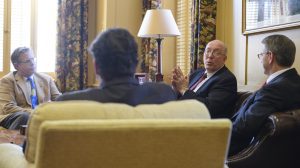
UM Vice Chancellor for Research Josh Gladden (far right) chats with (from left) ERDC Deputy Director David Pittman, NCPA Director Craig Hickey and ERDC Director James Holland during a visit Feb. 9 to the National Center for Physical Acoustics. Photo by Robert Jordan/Ole Miss Communications
OXFORD, Miss. – Several University of Mississippi administrators met with two top representatives from the U.S. Army Engineer Research and Development Center who visited campus Thursday (Feb. 9) to discuss strengthening mutually beneficial collaborations.
ERDC Director Jeff Holland and Deputy Director David Pittman visited Chancellor Jeffrey Vitter; Alex Cheng, dean of the School of Engineering; and Craig Hickey, interim director of the National Center for Physical Acoustics, to talk about funding opportunities and strategies. The ERDC officials also met with William Nicholas, director of the Hub at Insight Park; and Ryan Miller, associate director of the Haley Barbour Center for Manufacturing Excellence.
“We’ve had a wonderful relationship with the University of Mississippi for many years,” Holland said. “While it’s important that researchers at both ERDC and the university collaborate with each other, it’s also important that senior administrators at both places do the same. I believe we absolutely accomplished that objective today.”
Both Cheng and Hickey touted the value of the visit.
“In terms of engineering research, EDRC is one of the strongest assets in the state of Mississippi,” Cheng said. “The School of Engineering looks forward to educating students for high-tech careers who, hopefully, will seek and find employment at ERDC, thereby boosting the state’s economic growth.”
“As primarily a research organization on campus, NCPA and ERDC have multiple common research areas of interests,” Hickey said. “I can foresee scientists at both facilities continuing to communicate and increasing collaboration.”
Before Thursday’s meetings, UM and ERDC officials conducted visits, tours and calls at both sites. They agreed that the resilience of earthen dams and levees is a topic with mutual interest and capabilities that meets a national need.

Chancellor Jeffrey Vitter (left) enjoys conversations with (from left) ERDC Director James Holland and Deputy Director David Pittman during a visit to the Lyceum. Photo by Thomas Graning/Ole Miss Communications
“Over the past several years, UM and ERDC have put more energy into exploring collaborations, and we are excited about new opportunities that are emerging,” said Josh Gladden, interim vice chancellor for research and sponsored programs.
Last fall, the university signed an Educational Partnership Agreement and joined the ERDC Graduate Institute. The move allows both Ole Miss and ERDC to host coursework, pursue internships and engage in other activities.
The university and ERDC have shared interest and expertise in infrasound and earthen dam and levee monitoring and assessment, Gladden said.
“There are immediate opportunities in these fields for us to pursue together,” he said. “Other areas of potential collaboration are acoustic monitoring techniques for fish ecology, sediment transport, blast- resistant materials and general disaster resilience. As our relationship strengthens, it is likely this list will expand.
“Dr. Holland and I are on the same page about the need to foster higher-tech businesses in the state. They have looked at the business ecosystems around other large government research facilities which have vibrant small high-tech startups as potential models for ERDC and Vicksburg.”
Pittman and Miller said the agency’s partnership with the university will result in continued successful outcomes.
“We’ve had a wonderful association with the University of Mississippi for many decades,” Pittman said. “With new leaders coming into place, we look forward to our relationship becoming even stronger.”
“Having Drs. Holland and Pittman on campus was a great honor and a testament to the relationship we have with them and want to continue developing,” Miller said. “They had a great tour of the CME and discussed how manufacturing education here might play into research that ERDC is doing.”
UM is included in the elite group of R1: Doctoral Universities – Highest Research Activity by the Carnegie Classification of Institutions of Higher Education, the definitive list of the nation’s top doctoral research universities. The group, which includes Harvard, MIT and Johns Hopkins, represents 2.5 percent of institutions of higher education in the U.S.